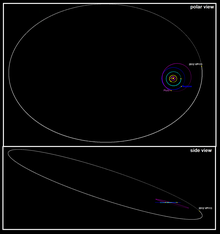 2012 VP113 imaged by the Canada–France–Hawaii Telescope on 9 October 2021 | |
| Discovery [1] [2] | |
|---|---|
| Discovered by | |
| Discovery site | Cerro Tololo Obs. |
| Discovery date | 5 November 2012 (announced: 26 March 2014) |
| Designations | |
| 2012 VP113 | |
| "Biden" (nickname) | |
| Orbital characteristics [3] | |
| Epoch 2022 Aug 09 (JD 2459800.5) | |
| Uncertainty parameter 3 | |
| Observation arc | 16.94 yr (6,187 d) |
| Earliest precovery date | 19 September 2007 |
| Aphelion | 462±1 AU |
| Perihelion |
|
| 271.5±0.6 AU | |
| Eccentricity | 0.7036±0.0007 |
| |
| 3.50° ±0.01° | |
| 0° 0m 0.792s / day | |
| Inclination | 24.0563°±0.006° |
| 90.787° | |
| ≈ 28 September 1979 [5] | |
| 293.8° | |
| Physical characteristics | |
| 574 km? [7] 300–1000 km [8] | |
| |
| 23.34 [11] | |
| 4.1 [3] | |
2012 VP113 is a trans-Neptunian object of the sednoid population, located in the outermost reaches of the Solar System. It was first observed on 5 November 2012 by American astronomers Scott Sheppard and Chad Trujillo at the Cerro Tololo Inter-American Observatory in Chile. [1] [2] The discovery was announced on 26 March 2014. [10] [12] The object probably measures somewhere between 300 and 1000 km in diameter, possibly large enough to be a dwarf planet.









